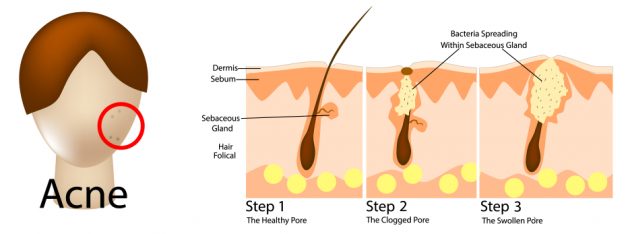Treatment Options for Acne Causing Bacteria
This is the first of articles on the 3 causes of acne. To read the second article on how your hormones influence acne click here. To read the third article on inflammation and dietary changes you can make to reduce acne click here.
The organism that is closely associated with in acne lesions is called Cutibacterium acnes. It had previously been called Propionibacterium acnes but has been recently renamed to be more accurate. It can be shortened to C acnes or P acnes. C acnes is an aerotolerant gram positive bacterium.
The Best Topical Antibiotics for Acne
 Typically the first line of defense against C acnes is a topical antibiotic called benzoyl peroxide (BPO). Peroxides are oxidants which can kill bacteria. BPO is available over the counter in strengths of 2.5%, 5%, or 10%. One study comparing the differences between the 3 strengths found that while all 3 strengths produced equal results, 2.5% benzoyl peroxide caused less irritation to the skin which made it more effective.
Typically the first line of defense against C acnes is a topical antibiotic called benzoyl peroxide (BPO). Peroxides are oxidants which can kill bacteria. BPO is available over the counter in strengths of 2.5%, 5%, or 10%. One study comparing the differences between the 3 strengths found that while all 3 strengths produced equal results, 2.5% benzoyl peroxide caused less irritation to the skin which made it more effective.
We believe that 2.5% is the ideal strength of BPO because the prescription acne treatment Epiduo contains 2.5% benzoyl peroxide with 0.1% adapalene retinoid. Based on the clinical evidence 2.5% BPO is a better choice in terms of topical antibiotics for acne.
Natural Alternatives to Benzoyl Peroxide
Some natural alternatives to BPO are available. One study found that a preparation of 5% tea tree oil was just as effective as 2.5% BPO. The study did note that while 5% tea tree oil was just as effective as BPO, it took longer to start working.
Other topical antibiotics include azelaic acid which is only available with a prescription.
Oral Antibiotics for Acne
 For more severe acne oral antibiotics are commonly used. Typical prescriptions used include tetracycline, minoxycycline, and doxycycline. These antibiotics are taken by mouth and released through the skin where it acts on the C acnes bacteria. These antibiotics also have an anti-inflammatory effect. Unfortunately side effects such as gastrointestinal discomfort are common with these antibiotics.
For more severe acne oral antibiotics are commonly used. Typical prescriptions used include tetracycline, minoxycycline, and doxycycline. These antibiotics are taken by mouth and released through the skin where it acts on the C acnes bacteria. These antibiotics also have an anti-inflammatory effect. Unfortunately side effects such as gastrointestinal discomfort are common with these antibiotics.






